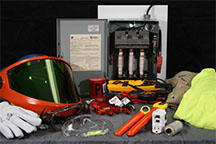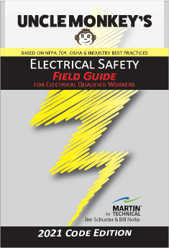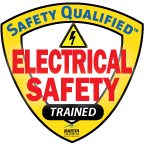Protect your workers and assets with our Electrical Safety & Arc Flash Training courses based on NFPA 70E®, OSHA, and industry best practices. Taught by experienced instructors who have real-world electrical skills experience and are trained professional instructors, we can teach to almost any task, electrical hazard or equipment for any type of industry. All training can be customized to your needs and can include hands-on training and validation.
Request a Quick QuoteThe Safety Qualified™ Electrical Safety and NFPA 70E® Arc Flash training course is designed to save lives, prevent disabling injuries, and prevent damage to plants, building and equipment.
Based on NFPA 70E®, students attending this course will gain an immense respect for the power of electricity. They will learn about personal safety for working on or around electrical systems and equipment, how to use proper materials and procedures for doing electrical work – and the potential consequences for themselves or others if they don’t. Students are given practical instruction applicable to their specific job or task while working on or around energized electrical equipment. This course also helps companies’ meet their OSHA training and Qualified Persons obligations as outlined in OSHA CFR 1910.331-335 and new NFPA 70E® standards that require training once every three years.
We offer a broad range of live electrical safety training courses to cover all needs, including:
Attendees will learn the following:
For the programs that include the Safety Qualified™ Electrical Worker Certification, students will put their knowledge and skills to test by demonstrating how to safely work on and around electrical equipment.
Different scenarios are created with live, finger safe voltages (24 volt) equipment, and the students must go through the process of creating an electrically safe environment before working, including proper circuit identification, and use of multimeters.
Safety Qualified™ Electrical Worker Testing & Certification
Our electrical safety training programs include our hands-on training and demonstration kits which provide examples of electrical PPE, tools and test equipment. An electrical disconnect box is also part of the demonstration kits.
Training on equipment at your location can also be done to provide students with real-world application of electrical safety practices.
Testing can be done through observation, oral quizzing or written tests.

Students will be provided with Uncle Monkey’s Electrical Safety Field Guide written by Martin Technical. This field guide is based on the most recent version of NFPA 70E® which is referenced throughout the training.
 This pocket book summarizes OSHA regulations as well as NFPA 70E® and is an excellent reference book for on-the-job information.
This pocket book summarizes OSHA regulations as well as NFPA 70E® and is an excellent reference book for on-the-job information.
 Students completing the course will receive a Safety Qualified™ – Electrical Safety Trained hard hat sticker as an important safety reminder to follow electrical safety policies and procedures.
Students completing the course will receive a Safety Qualified™ – Electrical Safety Trained hard hat sticker as an important safety reminder to follow electrical safety policies and procedures.
After completion of this course, students will receive a Certificate of Completion and .1 CEUs (Continuing Education Units) for each hour of class.

All training certificates will be stored by Martin Technical for future reference, validation and 3rd party documentation.
Best practices recommend the 2 or 3 day training programs in 3 year intervals, with 1 day or 1/2 day refreshers in between annually, Your company’s Electrical Safety Written Program may require more frequent training, so refer to this program prior to making any training determinations.
NFPA 70E® requires electrical safety training on intervals not to exceed 3 years, and when particular conditions exist, including:
– the employee is not following electrical safety practices
– new technologies, types of equipment or or changes have been introduced
– the employee’s job duties have changed.
OSHA CFR 1910.331-335 leaves it up to the employer for the frequency of training based on the hazards and tasks involved.
Both NFPA 70E® and OSHA training require that electrical safety training for Qualified Persons be done in the classroom or on-the-job, or a combination of the two. Ideally the formal training part is done live in the classroom with equipment and task training done on the job.
With the advent of technology, instructor-lead electrical safety webinars have become generally acceptable as an alternative to live training, however it has significant drawbacks. Most adult learners become bored and disengaged with webinars longer than 45 – 60 minutes, so performing a 1/2 day or 1 day webinar is extremely challenging for both the learners and instructor. Further, the webinars do not provide any hands-on or real-world training possibilities and are lecture only, requiring additional training to be done on site by the employer (see Electrical Qualified Person training requirements FAQ).
While OSHA has not changed its language on electrical training requirements, NFPA 70E® has expanded the definition of “classroom training” in a footnote to include “interactive electronic or interactive web-based training components.” These definitions can appear to be too broad and not in the spirit of the requirements by OSHA, depending on how the reader translates this footnote.
According to both NFPA 70E® and OSHA, a Qualified Person shall be trained and knowledgeable in the construction and operation of equipment of a specific work method and be trained to identify and avoid the electrical hazards that might be present with respect to that equipment or work method. This requires both formal classroom training to learn about electrical safety practices, and on the job training about the construction and operation of equipment, and work methods.
In addition, a Qualified Person must be trained to:
The only requirements is that the electrical safety training cover the necessary requirements by OSHA and NFPA 70E®. A shorter course (1/2 to 1 day) is normally for those who are experienced Qualified Persons and have already had full electrical safety training in the past 3 years and are using the shorter course as a refresher. To cover the updates with NFPA 70E® along with the standard requirements, 1.5 – 2 days of training is normally required. If you want hands-on training and validation, the training can be 3 – 5 days.
When looking at the length of training, there are several factors to consider, including:
There are no official code or standard requirements on who can teach electrical safety training as it is up to each employer to determine if the training instruction and quality meets their needs to protect workers from the hazards the encounter with their equipment and tasks.
That said, selecting a proper instructor is critical to make sure that all the requirements are covered for electrical safety training (see Electrical Qualified Person training requirements FAQ), and that all our your workforce can have their questions answered. If your instructor can’t select the right meter, know the limitations and know how use it on the proper circuits, they might know the code, but they really aren’t really qualified to teach electrical safety.
In short, a qualified electrical safety instructor should have the following
Notifications